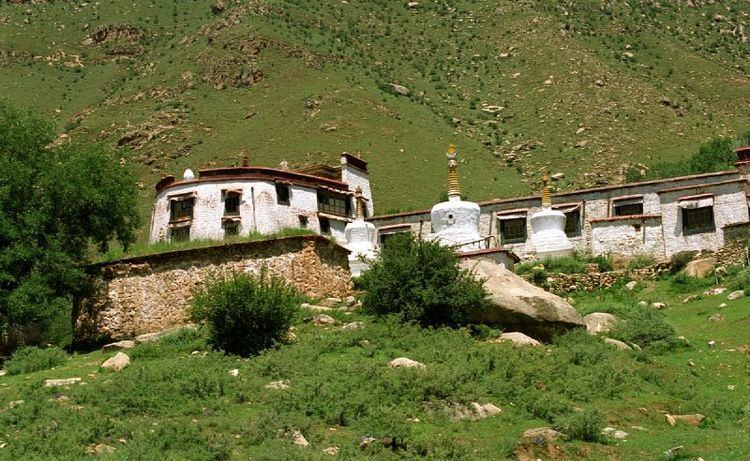Wylie transliteration Pha bong kha Simplified 帕邦喀 Type Tibetan Buddhist | Traditional 帕邦喀 Founded by Songtsän Gampo Founded 7th century | |
 | ||
Similar Sanga Monastery, Narthang Monastery, Yerpa, Ralung Monastery, Nechung | ||
Pabonka Hermitage (Pha bong kha), also written Pawangka, is a historical hermitage, today belonging to Sera Monastery, about 8 kilometres northwest of Lhasa in the Nyang bran Valley on the slopes of Mount Parasol (Dbu gdugs ri) in Tibet.
Contents
Founded by Songtsän Gampo in the 7th century, it is currently the largest and most important of the Sera hermitages and is the starting point for the “Sixth-Month Fourth-Day” (Drug pa tshe bzhi) of the Sera Mountain Circumambulation Circuit (Se ra’i ri ’khor) pilgrimage.
History
The site, which is over 1,300 years old, dates back to Songtsän Gampo, the founder of the Tibetan Empire, and was amongst the first buildings built in the Lhasa area by him during the 7th century after settlement. Although originally the site of his castle or fort, the Tibetan Annals have revealed that Pabonka was converted into a monastery, possibly under the reign of the second great Buddhist king of Tibet Trisong Detsen. Detsen, along with Guru Rinpoche and the first seven monks of the new Tibetan Empire used to meditate at the hermitage and it became one of Tibet's very earliest Buddhist monasteries, possibly even pre-dating Jokhang. The original nine-storied monastery was partially destroyed by King Langdharma in 841 during his campaign to destroy monastic Buddhism; it was rebuilt in the 11th century as a two-storied structure that housed 200 monks.
Je Tsongkhapa (1357–1419) lived at the site as a hermit, and it eventually became a scholarly institution. The Fifth Dalai Lama was known to be fond of the monastery and funded the building of an upper floor for Pabonka.
Before 1959, Pabonka was independent of Sera Monastery, and from 1960 to the mid-1980s it was controlled by the Chinese. It then came under the control of Sera, whose monks renovated it and are continuing its traditions.
Rigsum Gonpo Temple
This temple is noted for its many shrines, and its blue and carved gold mantra in the hallway, inscribed with words meaning, "Hail to the jewel in the lotus". A number of stone relics were buried during the Cultural Revolution but when Sera monks restored the hermitage they excavated the relics and restored most of them. A central shrine, dating back 1300 years to Gampo, is located in the temple and depicts Chenresig, Jampelyang and Chana Dorje, the so-called "Rigsum Gompo Trinity" from which the temple takes its name.
Pabonka Potrang
The upper floor of the Pabonka Potrang building, perched on a pile of rocks, has a notable assembly hall on the second floor and contains a photograph of the current abbot and a chenresig statue hidden on the right behind a pillar. The interior chapel contains an ancient conch shell (dungkhar) wrapped in a prayer scarf (kathak) displayed in a glass case. In the adjacent room is a four-pillared Kashima Lhakhang with statues of three kings and their wives and various eminent lamas. The rooftop quarters, intended for the Dalai Lama on his visits, contains a statue of the deity Demchok and offers panoramic views of the hillside towards Lhasa.
Palden Lhamo Cave
Up the hill from the hermitage, past a group of chortens, is Palden Lhamo Cave, a cave known to have been a meditation chamber of Songstan Gampo himself. Inside the cave are statues of Songtsän Gampo and his two wives. It also has a rock carving of Palden Lhamo, the protectress.
Jasa Potrang
Located near 108 chortens (stupas), which are a prominent feature of the monastery, is the ochre yellow brick building of Jasa Potrang, which is dedicated to Songtsän Gampo's wife, Princess Wencheng. On the upper floor of the building is a chapel with a small statue of her on the right and a depiction of Tibetan philologist Thonmi Sambhota who is believed to have invented the Tibetan alphabet at the hermitage, who is also recognised in the Valley of the Kings. Gampo's other wife, Bhrikuti, is called "honored". On the ground floor are the five manifestations of Tsongkhapa, and various Buddha statues with medical themes.
Traditions
The hermitage notably has its own tradition of monthly and yearly ritual cycles. The most important of these yearly ritual events (at least for the laity) are the six-day (three sets of two-day) Avalokiteśvara fasting rituals that take place during the Tibetan New Year (Losar) celebrations, the sixteen-day (eight sets of two-day) Avalokiteśvara fasting rituals that take place during the fourth Tibetan month (they attract many people from Lhasa and the surrounding districts), and a ritual and other events that take place during the “Sixth-Month Fourth-Day” pilgrimage.
